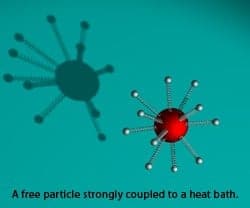A change of models demystifies anomalous particle behaviour at very low temperatures, confirming that the third law of thermodynamics cannot be violated
In theory, the laws of physics are absolute. However, when it comes to the laws of thermodynamics – the science that studies how heat and temperature relate to energy – there are times where they no longer seem to apply. In a paperrecently published in EPJ B, Robert Adamietz from the University of Augsburg, Germany, and colleagues have demonstrated that a theoretical model of the environment’s influence on a particle does not violate the third law of thermodynamics, despite appearances to the contrary. These findings are relevant for systems at the micro or nanometer scale that are difficult to decouple from the heat or the quantum effects exerted by their environment.
The authors focused on a model system favored by thermodynamics experts that consists of a free particle strongly coupled to a heat bath, representing the effect of its environment. Studies of such systems typically focus on how much energy is needed to raise their temperature by a certain amount, or so-called specific heat. Previous theoretical predictions suggested that, under certain circumstances, the specific heat can decrease below zero at a temperature of strictly zero (−273.15°C). This prediction appears to breach the third law of thermodynamics, which states that the specific heat must drop to zero value at strictly zero temperature.
The authors demonstrated that the third law of thermodynamics is not actually violated. In fact, a real particle will always be confined to a finite volume—even if that volume may be extremely large. Therefore, they discovered that previous studies need to be modified in order to account for a spatial confinement of the particle. The new model demonstrates how the negative specific heat for a truly free particle is related to a dip in the specific heat, which should be observable in the presence of a confinement.
Reference: R. Adamietz, G.-L. Ingold, and U. Weiss (2014), Thermodynamic anomalies in the presence of general linear dissipation: from the free particle to the harmonic oscillator,European Physical Journal B, DOI 10.1140/epjb/e2014-50125-2
If our reporting has informed or inspired you, please consider making a donation. Every contribution, no matter the size, empowers us to continue delivering accurate, engaging, and trustworthy science and medical news. Independent journalism requires time, effort, and resources—your support ensures we can keep uncovering the stories that matter most to you.
Join us in making knowledge accessible and impactful. Thank you for standing with us!

